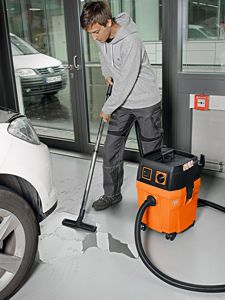 All all-purpose suckers can suck, but workshop vacuum cleaners can do more. They are equipped with an automatic socket and start automatically with a power tool plugged in here, to extract the dust generated during work directly from the machine. After switching off the tool, the workshop vacuum also stops automatically. Many models continue to run for a few seconds, to suck the dust out of the machine and the suction hose. A delay of five seconds is sufficient. Devices with a longer delay only make noise for an unnecessarily long time. For optimal filtering of the dusty air, workshop vacuum cleaners with a dust bag should be used. However, since these are relatively expensive, many users do without it in practice. However, fine dust is sucked directly into the large container, the fine filter clogs up quickly. Some devices are therefore equipped with manual or electromagnetic filter shaking, which cleans the filter again. The Alto simply shifts into reverse and blows the dust out of the filter.
All all-purpose suckers can suck, but workshop vacuum cleaners can do more. They are equipped with an automatic socket and start automatically with a power tool plugged in here, to extract the dust generated during work directly from the machine. After switching off the tool, the workshop vacuum also stops automatically. Many models continue to run for a few seconds, to suck the dust out of the machine and the suction hose. A delay of five seconds is sufficient. Devices with a longer delay only make noise for an unnecessarily long time. For optimal filtering of the dusty air, workshop vacuum cleaners with a dust bag should be used. However, since these are relatively expensive, many users do without it in practice. However, fine dust is sucked directly into the large container, the fine filter clogs up quickly. Some devices are therefore equipped with manual or electromagnetic filter shaking, which cleans the filter again. The Alto simply shifts into reverse and blows the dust out of the filter.
For wet vacuuming, not only the dust bag should be used for vacuum cleaners with round filters, but also the filter can be removed or replaced with a special foam filter. Does the normal filter get wet?, it is practically unusable.
SHOPPING TIP
■ Prüfen Sie vor dem Kauf, whether all parts required for operation are easily accessible and easy to handle. Workshop vacuum cleaners with flat filters on top are usually easier to use.
■ Achten Sie auf einen langen Saugschlauch, 3 to 4 m is the ideal length. A thin hose is sufficient for most jobs, only for planing you should prefer a thick hose. Antistatic hoses prevent static charges and sudden discharge with dangerous sparking.
■ Nehmen Sie ein Gerät mit großen Laufrollen. Small swivel castors often get stuck on tiny obstacles.
■ Filterqualität (alt) and dust classes (neu), indicated with letters, mark the devices. Select at least filter category G, better yet c, or dust class M or H.